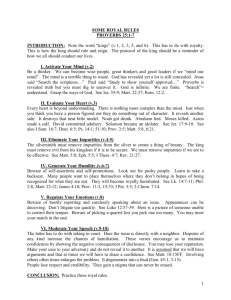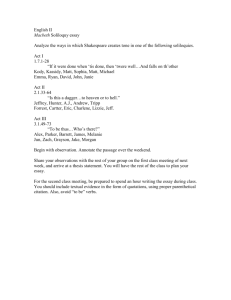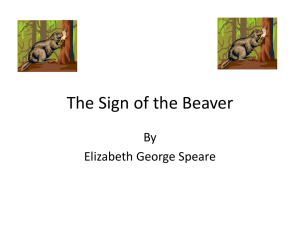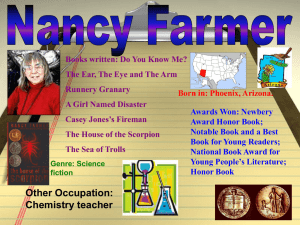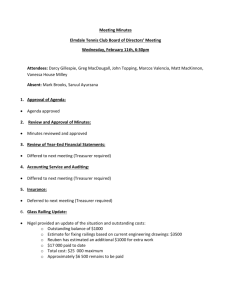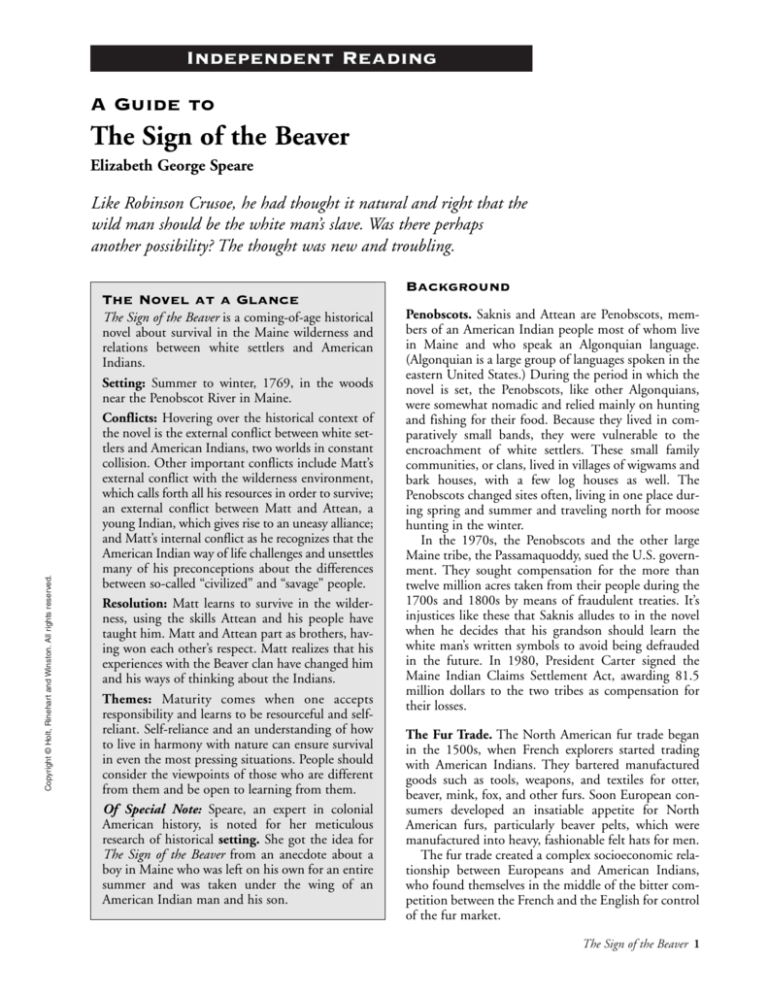
Independent Reading
A Guide to
The Sign of the Beaver
Elizabeth George Speare
Like Robinson Crusoe, he had thought it natural and right that the
wild man should be the white man’s slave. Was there perhaps
another possibility? The thought was new and troubling.
Background
Copyright © Holt, Rinehart and Winston. All rights reserved.
The Novel at a Glance
The Sign of the Beaver is a coming-of-age historical
novel about survival in the Maine wilderness and
relations between white settlers and American
Indians.
Setting: Summer to winter, 1769, in the woods
near the Penobscot River in Maine.
Conflicts: Hovering over the historical context of
the novel is the external conflict between white settlers and American Indians, two worlds in constant
collision. Other important conflicts include Matt’s
external conflict with the wilderness environment,
which calls forth all his resources in order to survive;
an external conflict between Matt and Attean, a
young Indian, which gives rise to an uneasy alliance;
and Matt’s internal conflict as he recognizes that the
American Indian way of life challenges and unsettles
many of his preconceptions about the differences
between so-called “civilized” and “savage” people.
Resolution: Matt learns to survive in the wilderness, using the skills Attean and his people have
taught him. Matt and Attean part as brothers, having won each other’s respect. Matt realizes that his
experiences with the Beaver clan have changed him
and his ways of thinking about the Indians.
Themes: Maturity comes when one accepts
responsibility and learns to be resourceful and selfreliant. Self-reliance and an understanding of how
to live in harmony with nature can ensure survival
in even the most pressing situations. People should
consider the viewpoints of those who are different
from them and be open to learning from them.
Of Special Note: Speare, an expert in colonial
American history, is noted for her meticulous
research of historical setting. She got the idea for
The Sign of the Beaver from an anecdote about a
boy in Maine who was left on his own for an entire
summer and was taken under the wing of an
American Indian man and his son.
Penobscots. Saknis and Attean are Penobscots, members of an American Indian people most of whom live
in Maine and who speak an Algonquian language.
(Algonquian is a large group of languages spoken in the
eastern United States.) During the period in which the
novel is set, the Penobscots, like other Algonquians,
were somewhat nomadic and relied mainly on hunting
and fishing for their food. Because they lived in comparatively small bands, they were vulnerable to the
encroachment of white settlers. These small family
communities, or clans, lived in villages of wigwams and
bark houses, with a few log houses as well. The
Penobscots changed sites often, living in one place during spring and summer and traveling north for moose
hunting in the winter.
In the 1970s, the Penobscots and the other large
Maine tribe, the Passamaquoddy, sued the U.S. government. They sought compensation for the more than
twelve million acres taken from their people during the
1700s and 1800s by means of fraudulent treaties. It’s
injustices like these that Saknis alludes to in the novel
when he decides that his grandson should learn the
white man’s written symbols to avoid being defrauded
in the future. In 1980, President Carter signed the
Maine Indian Claims Settlement Act, awarding 81.5
million dollars to the two tribes as compensation for
their losses.
The Fur Trade. The North American fur trade began
in the 1500s, when French explorers started trading
with American Indians. They bartered manufactured
goods such as tools, weapons, and textiles for otter,
beaver, mink, fox, and other furs. Soon European consumers developed an insatiable appetite for North
American furs, particularly beaver pelts, which were
manufactured into heavy, fashionable felt hats for men.
The fur trade created a complex socioeconomic relationship between Europeans and American Indians,
who found themselves in the middle of the bitter competition between the French and the English for control
of the fur market.
The Sign of the Beaver 1
Matthew (Matt) Hallowell, a resourceful, independent thirteen-year-old who has been left alone to watch
over his family’s new cabin in the Maine wilderness
while his father goes back to Massachusetts for the rest
of the family.
Matt’s father, a hardy, forward-looking pioneer who
has taught Matt to be self-reliant; he displays a respectful attitude toward American Indians.
Saknis, a noble, elderly Indian who saves Matt’s life; he
is leader of the Beaver clan.
Attean, Saknis’s proud fourteen-year-old grandson.
Plot
Chapter 1. The novel begins as Matt watches his father
disappear into the wilderness on a trek to Quincy,
Massachusetts, to fetch Matt’s sister Sarah and their
pregnant mother. Matt is left with provisions and two
important items that will figure prominently in the
plot: a prized rifle and an heirloom watch. Matt’s father
also advises him to keep track of the passing weeks by
making notches on sticks.
Chapter 2. Matt discovers that his time alone is passing quickly and pleasantly, except for some anxiety
about Indians. Although there have been no Indian
attacks in this part of Maine since the last treaty with
the tribes, Matt can’t forget the frightening tales he’s
heard. And he sometimes feels that someone is watching him from the forest.
Chapter 3. Late one afternoon, Matt has an unexpected visitor: a large, red-bearded trapper named Ben,
who has come to the cabin in search of a meal and a
night’s sleep. Matt feels an internal conflict: He is
uneasy about the stranger but has been taught to be gracious to company. So he instinctively lies to Ben, telling
him that his father is due back that evening. Matt also
resolves to stay awake and keep an eye on Ben all
night—but he falls asleep. In the morning he finds to
his horror that Ben has stolen his father’s rifle. This
complication will make Matt’s survival difficult.
Chapter 4. Without the rifle, Matt has to procure food
by fishing. Another complication arises one morning
when he becomes careless and forgets to secure the
cabin door. When he comes back from his fishing trip,
he finds that a bear has invaded the cabin and raided his
provisions.
Chapter 5. Matt climbs a bee tree to get honey. When
he reaches into a hole to grab some honeycomb, bees
attack him. Covered with bee stings, Matt runs wildly
into a pond. Near unconsciousness and caught by his
leg in underwater plants, he feels strong arms lift him
out of the water. Two Indians, an elderly man and a
boy, remove stingers from his body and take him safely
back to the cabin.
2 The Sign of the Beaver
Chapter 6. Matt wakes to find himself feeling better. The
elderly Indian returns to the cabin to bring him food.
Matt, feeling instinctive trust for this man, reveals that he
is all alone, waiting for his family to return. The man
introduces himself as Saknis, and Matt is confirmed in his
earlier intuition about having been watched from the forest: Saknis has indeed been observing Matt for some time.
The next day Saknis returns with his grandson,
Attean, a stern fourteen-year-old who seems disdainful
of Matt and the cabin. Saknis gives Matt a crutch for
his injured leg and notices that Matt has lost one boot.
Three days later he returns with a new pair of moccasins. Realizing that the old man has not only saved his
life but has continued to help him, Matt gives Saknis
the only meaningful possession he can part with—his
beloved copy of Robinson Crusoe. After accepting the
gift stoically, Saknis holds it upside down, and Matt
realizes that the man can’t read. Saknis suddenly smiles
and suggests a treaty: His grandson Attean will hunt
food for Matt in exchange for reading lessons for
Attean. Attean reacts to this idea with hostility, but
Saknis insists. Learning to read the white man’s language, he explains, will enable his people to understand
written treaties—so that they can avoid the mistake of
signing away their lands. The stage is set for a reluctant
partnership between Matt and Attean, one of the central conflicts in the novel.
Chapter 7. Matt creates a schoolroom in the cabin.
When Attean arrives with a rabbit, Matt opens
Robinson Crusoe and starts to teach Attean the letter A.
When Attean finds out that it will probably take him
many months to learn how to read, he angrily knocks
the book off the table and storms out of the cabin.
Chapter 8. Trying a new tactic the next day, Matt reads
aloud an interesting portion of Robinson Crusoe. The
seemingly stoic Attean gets caught up in the story, and
he returns the next day for a continuation. Attean,
however, criticizes many parts of Robinson Crusoe, causing Matt to reconsider some aspects of the book, particularly its notion of the superiority of white men to
“savages.” In the process, he begins to understand
Attean’s reactions to the story.
Chapter 9. Attean, at Matt’s request, shows him how to
make a rabbit snare out of a plant root. In a few days,
Matt becomes a proficient hunter with the snare, and
he announces that he won’t be needing any more presents of food. Attean, though, continues to bring game,
evidently feeling bound by his grandfather’s treaty.
Then Matt learns that Attean’s real motivation for persevering is to hear more of the story of Robinson
Crusoe. When Matt reads the scene in which the native
man, Friday, kneels before Crusoe and swears to be his
slave, Attean gets upset and angry. He protests that the
character would never kneel to a white man. This
episode fuels Matt’s internal conflict, through which
he reassesses his views of the relationship between
whites and “savages.”
Copyright © Holt, Rinehart and Winston. All rights reserved.
Main Characters
(in order of appearance)
Chapter 10. As the reading lessons continue, Matt carefully edits out any references to the slave-master relationship between Friday and Crusoe. Unexpectedly,
Attean invites Matt to go fishing. Matt does poorly with
a spear Attean lends him; and when he falls in the water,
he feels that Attean is mocking him. Resentful, Matt
fishes in his own way. However, when he loses his hook,
Attean shows him how to make new hooks from twigs.
Chapter 11. Seven weeks have passed and Matt’s family has yet to arrive. Attean and Matt often go off hunting and fishing, sometimes with Attean’s mangy dog.
One day, Attean explains a sign on a tree stump—a picture of a beaver. It indicates that this is the hunting territory of his people, the Beaver clan; no other clan can
hunt there. Attean shows Matt how to avoid getting
lost in the forest by making secret signs to mark the
route he has traveled. Matt suddenly realizes that he
and Attean are reversing the roles in the story of
Robinson Crusoe: The “savage” is teaching the white
man. Matt also becomes aware that he deeply wants to
earn Attean’s respect.
Chapter 12. Matt decides that he wants a bow and
arrows. Attean helps him make a good bow, using a particular kind of wood and a painstaking process that tries
Matt’s patience.
Copyright © Holt, Rinehart and Winston. All rights reserved.
Chapter 13. One day in the forest, the boys come
across a fox in an iron trap, an incident that foreshadows a key event later in the novel. Matt wants to end
the fox’s suffering, but Attean refuses. The fox is on
clearly marked Turtle clan territory, he explains, and a
member of the Beaver clan cannot hunt there. While
admitting that using white men’s traps is wrong, Attean
explains that some Indians are reluctantly starting to
use them to compete with white trappers.
Chapter 17. Matt learns that not everyone in the village is happy to have him as company: Attean’s grandmother hates all white men, because her daughter,
Attean’s mother, was killed by white men for no reason
when Attean was a small child. After that tragedy,
Attean’s father went out to find his wife’s killers and
never returned. On his way home from the village,
Matt notices many signs of the beaver, and he realizes
that he could easily find his way back to the clan’s village one day.
Chapter 18. A key chapter: It is autumn, and while far
away from the cabin, Matt hears a yelping dog. He discovers that it is Attean’s dog, caught in the same kind of
iron trap that the fox had been caught in earlier. Matt
tries to free the frantic dog, but the panicked creature
tries to attack him. After Matt’s arm is wounded in the
attempt, he goes to the Beaver village to fetch Attean.
Attean, however, has gone away with all the men to
hunt. Matt insists on seeing Attean’s grandmother, a
brave move given that he knows she hates him. The
grandmother does not understand English, but Attean’s
sister Marie translates for him. Matt manages to convince both of them that the dog is worth saving for
Attean’s sake. After the grandmother dresses Matt’s
wound, Marie accompanies him to the site of the trap.
The two manage to free the dog.
Chapter 19. Two days later the grandmother, impressed
that Matt went to so much trouble for Attean’s dog,
sends Attean to invite Matt back to the village. Attean
shows Matt all around the village, and then they join
some other boys in games. As Matt departs, he feels he
has passed a test: He has been accepted by the Beaver
clan, and he is finally respected by Attean. He no longer
feels alone.
Chapter 14. Matt finishes reading Robinson Crusoe to
Attean, who reveals that he has been telling the rest of
the tribe the story in episodes every night. Matt decides
to share more stories with Attean by reading from his
father’s Bible.
Chapter 20. Matt doesn’t hear from Attean for a week.
When Attean returns, he appears very serious. He tells
Matt that he is leaving to seek his manitou—his
spirit—which he must find before he can be considered
a man and a hunter.
Chapter 15. In this turning-point chapter, an important external conflict brings Matt and Attean closer
together. Matt makes his first successful rabbit kill with
the bow and arrow and is happy that Attean is there to
witness it. Then, on their way to the beaver dam, the
boys encounter a bear cub and its angry mother—ready
to charge. Instinctively, Matt hurls the dead rabbit at
the bear’s nose, giving Attean time to shoot two arrows
at the bear and then charge it with a knife. Matt is puzzled when Attean apologizes to the bear for killing it,
but he gratefully accepts Attean’s compliment that he
acted quickly, like an Indian. At last Matt has earned
some much-desired respect from Attean.
Chapter 21. One morning a changed Attean returns to
Matt’s cabin with Saknis. Matt can tell that Attean has
found his manitou, because his head is shaved like an
adult male’s and he is carrying a rifle. Saknis explains
that it is time to head north to hunt moose and invites
Matt to join the Beaver clan on the hunt. With the
approaching winter, Matt will find survival difficult,
and he will be truly alone. Saknis voices Matt’s biggest
anxiety: His father may never return. Now Matt wrestles with an inner conflict. He is tempted to join
Saknis and Attean, but he knows that it is his responsibility to stay on his father’s land. Matt’s loyalty to his
family wins out, and he decides to stay.
Chapter 16. After the triumph over the bear, Attean
invites Matt to his tribe’s village for a feast of bear meat.
In a carefully detailed description of setting, we get our
first glimpse of the Penobscot clan’s village.
Chapter 22. In the novel’s bittersweet climax, Attean
and Matt part ways. Four days later Attean returns with
his dog to ask if Matt has changed his mind about
coming. After Attean reveals his respect for his friend’s
The Sign of the Beaver 3
Chapter 23. With winter settled in, Matt spends his
days tending to tasks of survival. He creates winter
clothing for himself and is proudest of his homemade
otter-fur cap.
Chapter 24. It is nearly Christmas and the first snowfall comes one afternoon. By the next morning, Matt is
almost trapped in the cabin by a bank of snow.
Strapping on snowshoes that Saknis had given him, he
discovers the joy of tramping about in the snow. In this
newly benign setting, Matt realizes he is happy for the
first time since Attean went away.
Chapter 25. The novel reaches a happy resolution:
Three days after the snowstorm, Matt’s family returns.
His mother looks thin and pale, and Matt discovers
the reasons for his family’s delay: They contracted
typhus, and the frozen river forced them to stay at a
trading post. Eventually they had to make the rest of
the journey overland by sled. Matt also learns that the
new baby died after five days; his mother is still grieving. Matt’s mother remarks that several families are
moving to the area. Matt, who has begun to think like
Attean, finds this possibility less than appealing. While
resolving to tell his family about Attean and the Beaver
clan later, he knows they will never fully understand
his experiences.
Approaches for
Post-Reading Activities
Speare is noted for both her evocation of setting and
her handling of characterization, and both literary elements figure prominently in the novel. Its focus on a
specific time and place makes it an excellent adjunct to
American history studies. Discussion groups or students
working on individual research projects might favor the
Copyright © by Holt, Rinehart and Winston, Inc.
All rights reserved. No part of this publication may be reproduced
or transmitted in any form or by any means, electronic
or mechanical, including photocopy, recording, or any information
storage and retrieval system.
Printed in the United States of America
4 The Sign of the Beaver
following activity.
Researching Colonial America
Elizabeth George Speare always conducted painstaking
research for her novels, often going to primary sources
for information. Here are some ideas for subjects students might want to research:
• How did colonial Americans live? How large were
families, and what kinds of homes would you have
found in the Northeast?
• What did people eat, and how did they provide for
themselves? What was the average life expectancy?
What diseases, disasters, and crimes did colonial settlers have to cope with?
• What economic problems did settlers face? What were
their interactions with American Indians like?
• What problems did Penobscots face as white settlers
moved into their land? What are they doing today?
Meet the Writer
Elizabeth George Speare (1908–1994) was born in
Melrose, Massachusetts, where she grew up in a large,
happy extended family. After graduating from Boston
University in 1930, Speare taught high school English
while earning a master’s degree. In 1936, she married
and then moved to Connecticut. Speare spent all her
life in New England, the setting of Sign of the Beaver.
Her secure reputation as a writer for young people rests
on just four books, the best known of which, The Witch
of Blackbird Pond, is one of the few books ever to be
awarded the Newbery Medal by unanimous vote.
Read On
Mary Whitebird, “Ta-Na-E-Ka.” In this short story,
eleven-year-old Mary experiences Ta-Na-E-Ka, a traditional Kaw Indian rite of passage involving survival
skills and endurance.
Anne McCaffrey, “The Smallest Dragonboy.” A
short story about self-reliance and coming-of-age issues.
On the planet Pern, an unlikely candidate, twelve-yearold Keevan, strives to achieve his dream of becoming a
dragonrider.
Virginia Driving Hawk Sneve, “The Medicine Bag.”
In this short story, a Sioux Indian boy learns to accept
his Sioux heritage and receives his family’s medicine bag.
Copyright © Holt, Rinehart and Winston. All rights reserved.
decision to remain, Matt reflects on the irony that a
simple decision to stay put has earned him more respect
than any amount of heroic action. Attean explains that
his people will move west, where they think there are
no white men. Matt knows better but says nothing to
spoil Attean’s hopes for the future. As a parting gift,
Attean gives Matt his beloved old dog, a companion for
his “white brother.” Deeply moved, Matt decides to
give Attean in return his most precious possession: the
silver watch that his father bequeathed him.




